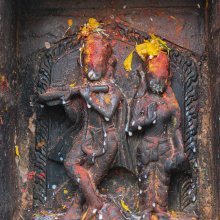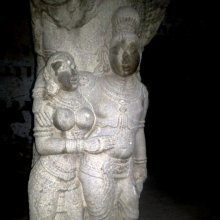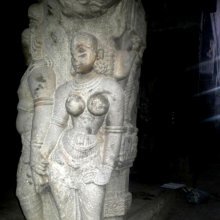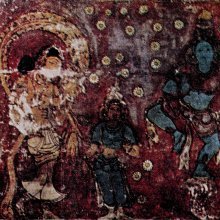Radha, Rādhā, Rādha, Rāḍha, Rāḍhā: 26 definitions
Introduction:
Radha means something in Buddhism, Pali, Hinduism, Sanskrit, Jainism, Prakrit, the history of ancient India, Marathi, Hindi. If you want to know the exact meaning, history, etymology or English translation of this term then check out the descriptions on this page. Add your comment or reference to a book if you want to contribute to this summary article.
Images (photo gallery)
In Hinduism
Purana and Itihasa (epic history)
Source: archive.org: Puranic Encyclopedia1) Rādhā (राधा).—Śrī Kṛṣṇa’s dearest consort. Rādhā is considered to be one of the two forms of Lakṣmīdevī. When Kṛṣṇa lived in Gokula as a man with two hands Rādhā was his dearest consort. But when he lives in Vaikuṇṭha as four-handed Viṣṇu, Lakṣmī is his dearest consort. (Devī Bhāgavata 9, 1; Brahmavaivarta Purāṇa, 2, 49 and 56-57 and Ādi Parva Chapter 11).
Different versions about the birth of Rādhā are given in the Purāṇas, as follows:—
(i) She was born in Gokula as daughter of Vṛṣabhānu and Kalāvatī. (Brahmavaivarta Purāṇa, 2, 49; 35-42; Nārada Purāṇa, 2. 81).
(ii) She was got as Bhūmi-kanyā (earth-girl) when King Vṛṣabhānu was preparing the ground to conduct a Yajña. (Padma Purāṇa; Brahma Purāṇa 7).
(iii) She was born from the left side of Kṛṣṇa. (Brahmavaivarta Purāṇa).
(iv) At the time of Kṛṣṇa’s birth Viṣṇu asked his attendants to be born on earth. Accordingly Rādhā, dear consort of Kṛṣṇa, took her birth in Gokula under the star Jyeṣṭhā in the morning of Śuklāṣṭamī day in Bhādrapada month. (Ādi Parva 11),
(v) Kṛṣṇa once went with Virajā, the Gopī woman, to the hall of enjoyment (rāsamaṇḍalam). Knowing about it Rādhā followed them to the hall, but both of them were not to be seen. On another occasion when Rādhā found Virajā in the company of Kṛṣṇa and Sudāmā she, in great anger, insulted Kṛṣṇa whereupon Sudāmā cursed her to be born in human womb and experience the pangs of separation from Kṛṣṇa. (Nārada Purāṇa 2. 8; Brahmavaivarta Purāṇa. 2. 49) and Rādhā cursed him in turn to be born in the dānava dynasty. It was on account of this curse of Rādhā that Sudāmā was born as the asura called Śaṅkhacūḍa. (Brahma Vaivarta Purāṇa, 2. 4. 9. 34).
(vi) Rādhā is considered to be one of the five forces which help Viṣṇu in the process of creation. (Devī Bhāgavata 9. 1; Nārada Purāṇa 2. 81).
(vii) Rādhā is the mental power of Śrī Kṛṣṇa. (For details see under Pañcaprāṇas).
2) Rādhā (राधा).—Wife of Adhiratha, the foster-father of Karṇa and the foster-mother of Karṇa. (See under Karṇa).
Source: archive.org: Shiva Purana - English TranslationRādhā (राधा) is the wife of Kṛṣṇa and was born as the daughter of Kalāvatī, after the latter was cursed by Sanatkumāra, according to the Śivapurāṇa 2.3.2.—Accordingly, as Sanatkumāra said to the three daughters of Svadhā (i.e., Menā, Dhanyā, Kalāvatī) after cursing them:—“[...] O ye three daughters of forefathers (i.e., Kalāvatī), listen with pleasure to my words that will dispel your sorrow and bestow happiness on you. [...] The youngest Kalāvatī shall be the wife of the Vaiśya—Vṛṣabhāna. At the end of Dvāpara, Rādhā shall be her daughter. [...] Kalāvatī by the virtue of Vṛṣabhāna shall become a living liberated soul and attain Goloka along with her daughter. There is no doubt about it. [...] Ye the daughters of forefathers (i.e., Kalāvatī) shall shine in heaven. By the vision of Viṣṇu your evil actions have been quelled. [...] Kalāvatī’s daughter Rādhā, resident of Goloka (i.e., golokavāsin) shall become the wife of Kṛṣṇa united with him in secret love”.
Source: Cologne Digital Sanskrit Dictionaries: The Purana Index1a) Rādhā (राधा).—Came with Kṛṣṇa to mediate between Paraśurāma and Vināyaka; spoke on the non-differentiation of Śiva and Viṣṇu; Gaṇeśa was a Vaiṣṇava and Paraśurāma Śaiva.*
- * Brahmāṇḍa-purāṇa III. 42. 21, 47-8; 43. 21 and 29; 44. 29; Vāyu-purāṇa 104. 52.
1b) The goddess enshrined at Vṛndāvana.*
- * Matsya-purāṇa 13. 38.

The Purana (पुराण, purāṇas) refers to Sanskrit literature preserving ancient India’s vast cultural history, including historical legends, religious ceremonies, various arts and sciences. The eighteen mahapuranas total over 400,000 shlokas (metrical couplets) and date to at least several centuries BCE.
Shaktism (Shakta philosophy)
Source: Wisdom Library: ŚāktismRādha (राध) is the name of a Śāktapīṭha mentioned in the Kulārṇavatantra. The Kulārṇava-tantra is an important 11th century work for the Kaula school of Śāktism. It refers to eighteen such Śākta-pīṭhas (e.g. Rādha) which is defined as a sacred sanctuary of Devī located here on earth. According to legend, there are in total fifty-one such sanctuaries (pīṭha) on earth, created from the corresponding parts of Devī’s body,

Shakta (शाक्त, śākta) or Shaktism (śāktism) represents a tradition of Hinduism where the Goddess (Devi) is revered and worshipped. Shakta literature includes a range of scriptures, including various Agamas and Tantras, although its roots may be traced back to the Vedas.
Vaishnavism (Vaishava dharma)
Source: Pure Bhakti: Brhad BhagavatamrtamRādhā (राधा) refers to:—The eternal consort of Śrī Kṛṣṇa and the embodiment of the hlādinī potency, known as mahābhāva-svarūpinī, the personification of the highest ecstacy of divine love. She is the source of all the gopīs, the queens of Dvārakā, and the Lakṣmīs of Vaikunṭha. (cf. Glossary page from Śrī Bṛhad-bhāgavatāmṛta).

Vaishnava (वैष्णव, vaiṣṇava) or vaishnavism (vaiṣṇavism) represents a tradition of Hinduism worshipping Vishnu as the supreme Lord. Similar to the Shaktism and Shaivism traditions, Vaishnavism also developed as an individual movement, famous for its exposition of the dashavatara (‘ten avatars of Vishnu’).
Natyashastra (theatrics and dramaturgy)
Source: Shodhganga: Bhismacaritam a critical study (kavya)Rādhā (राधा) or Rādhācarita is the name of a Carita-Kāvya type of Mahākāvya (‘epic poem’).—These carita-kāvyas play an important role in the field of Sanskrit language as biography is a significant sector of any literature. They mainly form a part of biographical literature. [...] The Rādhā-carita was written by Hari Narayan Dikshit.

Natyashastra (नाट्यशास्त्र, nāṭyaśāstra) refers to both the ancient Indian tradition (shastra) of performing arts, (natya—theatrics, drama, dance, music), as well as the name of a Sanskrit work dealing with these subjects. It also teaches the rules for composing Dramatic plays (nataka), construction and performance of Theater, and Poetic works (kavya).
General definition (in Hinduism)
Source: WikiPedia: HinduismRādhā (राधा): Rādhā is one of the gopis (cow-herding girls) of the forest of Vrindavan, Krishna plays with her during his upbringing as a young boy; The other Radha is the wife of the charioteer Adhiratha, who found an abandoned new-born boy, whom he named Karna.
In Buddhism
Theravada (major branch of Buddhism)
Source: Pali Kanon: Pali Proper Names1. Radha
A parrot, brother of Potthapada, the Bodhisatta. See the Radha Jataka (1). He is identified with Ananda. J.i.496.
2. RadhaThe Bodhisatta born as a parrot. See the Radha Jataka (2).
3. RadhaThe Bodhisatta born as a parrot. See the Kalabahu Jataka.
4. Radha TheraHe was a brahmin of Rajagaha who, being neglected by his children in his old age, sought ordination. The monks refused his request on the ground of his age, so he sought the Buddha who, seeing his upanissaya, asked Sariputta to admit him.* Soon after he won arahantship.
He stayed near the Buddha, and, by reason of his skill, the Buddha declared him foremost among those who could inspire speech in others (? patibhanakeyyanam) (A.i.25; ThagA.i.253f).
He thereby earned the name of Patibhaniya Thera (SA.ii.246).
The Theragatha (vss.133 4) contains two verses spoken by him in praise of concentration of the mind.
The Radha Samyutta (S.iii.188 201; see also Radha Sutta) contains a large number of suttas preached by the Buddha in answer to Radhas questions on various topics.
It is said that when the Buddha saw Radha he felt the inclination to talk on matters dealing with subtle topics, illustrating them with various similes. SA.ii.246; this was because of Radhas wealth of views (ditthisamudacara) and unwavering faith (okappaniya saddha); AA.i.179; also ThagA.i.254.
* It is probably this incident which is referred to at ThagA.ii.114, where Sariputta is said to have ordained a poor brahmin named Radha, but no mention is made of any order from the Buddha. If the reference is to this same thera, Radha was, for some time, the attendant (pacchasamana) of Sariputta, and there is a verse in Thag. (993) spoken to him by Sariputta, who was pleased with Radhas gentle manner. DhA.ii.104ff. gives more details of the ordination of Radha. There we are told that he went to the monastery where he performed various duties. But the monks would not admit him into the Order, and, owing to his disappointment, he grew thin. One day the Buddha, seeing him with his divine eye, went to him, and hearing of his wish to join the Order, summoned the monks and asked if any of them remembered any favour done by Radha. Sariputta mentioned that he had once received a ladleful of Radhas own food while begging in Rajagaha. The Buddha then suggested that Sariputta should listen to Radhas request for ordination. After ordination, Radha grew weary of the food of the refectory, but Sariputta constantly admonished him and found him most humble; later, he spoke highly of Radhas obedience, and the Buddha praised him. It was on Radhas account that the Alinacitta Jataka was preached. AA.i.179f. agrees, more or less, with the account given above; so does Ap.ii.485f.
-- or --
. One of the two chief women disciples of Paduma Buddha. Bu.ix.22. Theravāda is a major branch of Buddhism having the the Pali canon (tipitaka) as their canonical literature, which includes the vinaya-pitaka (monastic rules), the sutta-pitaka (Buddhist sermons) and the abhidhamma-pitaka (philosophy and psychology).
Mahayana (major branch of Buddhism)
Source: Wisdom Library: Maha Prajnaparamita SastraRādha (राध) is the name of an “assistant” (upasthāyaka) of Buddha Śākyamuni, according to the 2nd century Mahāprajñāpāramitāśāstra chapter XLI. When the Buddha Śākyamuni once attained enlightenment, Meghiyā, Rādha, Sunakṣatra, Ānanda, Guhyaka the Malla, etc., formed his close entourage.”

Mahayana (महायान, mahāyāna) is a major branch of Buddhism focusing on the path of a Bodhisattva (spiritual aspirants/ enlightened beings). Extant literature is vast and primarely composed in the Sanskrit language. There are many sūtras of which some of the earliest are the various Prajñāpāramitā sūtras.
In Jainism
General definition (in Jainism)
Source: HereNow4u: Lord Śrī MahāvīraRāḍha (राढ) is the name of a village visited by Mahāvīra during his fifth year of spiritual-exertion.—After Kalambukā, he decided to go to Lāḍha (Rāḍha) country, considered as Anārya where no monk or ascetic would even imagine going. There were two divisions of Lāḍha country north and south, or Vajra and Śubhra. The river Ajaya used to flow in between. In Lāḍha country, there were no suitable places to stay for the Lord. Even tasteless, minimal food used to come about with great difficulty.
Rāḍha or Lāḍha was also visited by Mahāvīra during his ninth year of spiritual-exertion.—After leaving Rājagṛha, the Lord thought again that truly, it is possible to annhilate karmas only in Anārya region. Thinking thus, he again left for the Anārya Lāḍha and Śubhrabhūmi. People there were insensitive, cruel and without compassion. Hence, the Lord bore with different troubles with equanimity. When he did not get the right place, he completed the monsoon time in ruins, under trees, or simply wandering about. This way, wandering in Anārya region, the Lord re-entered the Ārya region. From the Anārya region the Lord was going to ‘Siddhārthapura’ and from there to ‘Kūrmagrāma’ and Gośālaka was with him, too.

Jainism is an Indian religion of Dharma whose doctrine revolves around harmlessness (ahimsa) towards every living being. The two major branches (Digambara and Svetambara) of Jainism stimulate self-control (or, shramana, ‘self-reliance’) and spiritual development through a path of peace for the soul to progess to the ultimate goal.
India history and geography
Source: What is India: Epigraphia Indica volume XXXI (1955-56)Rāḍhā is the name of an ancient city mentioned in the “Asankhali plates of Narasiṃha II” (1302 A.D.). Rāḍhā and Vārendra, described indirectly as the land of the Javanas (Yavanas or Muhammadans), have to be identified respectively with South-western and Northern Bengal.
These copper plates (mentioning Rāḍhā) were discovered from the house of a Santal inhabitant of Pargana Asankhali in the Mayurbhanj State (Orissa). It was made when king Vīra-Narasiṃhadeva was staying at the Bhairavapura-kaṭaka (city, camp or residence).
Source: Cologne Digital Sanskrit Dictionaries: Indian Epigraphical GlossaryRādhā.—(EI 8), a posture of standing with the feet a span apart. Note: rādhā is defined in the “Indian epigraphical glossary” as it can be found on ancient inscriptions commonly written in Sanskrit, Prakrit or Dravidian languages.

The history of India traces the identification of countries, villages, towns and other regions of India, as well as mythology, zoology, royal dynasties, rulers, tribes, local festivities and traditions and regional languages. Ancient India enjoyed religious freedom and encourages the path of Dharma, a concept common to Buddhism, Hinduism, and Jainism.
Languages of India and abroad
Marathi-English dictionary
Source: DDSA: The Molesworth Marathi and English Dictionaryrādhā (राधा).—f (From rādhā the favorite mistress of kṛṣṇa) A man dressed in woman's clothes as a dancer.
Source: DDSA: The Aryabhusan school dictionary, Marathi-Englishrādhā (राधा).—f A man dressed in woman's clothes as a dancer.
Marathi is an Indo-European language having over 70 million native speakers people in (predominantly) Maharashtra India. Marathi, like many other Indo-Aryan languages, evolved from early forms of Prakrit, which itself is a subset of Sanskrit, one of the most ancient languages of the world.
Sanskrit dictionary
Source: DDSA: The practical Sanskrit-English dictionaryRāḍhā (राढा).—
1) Lustre.
2) Name of a district in Bengal, as also of its capital; गौडं राष्ट्रमनुत्तमं निरुपमा तत्रापि राढापुरी (gauḍaṃ rāṣṭramanuttamaṃ nirupamā tatrāpi rāḍhāpurī) Prab.2.
--- OR ---
Rādha (राध).—
1) The month called Vaiśākha.
-dhaḥ, -dham 1 Favour, kindness.
2) Prosperity.
-dhī The day of full moon in the month of Vaiśākha.
Derivable forms: rādhaḥ (राधः).
--- OR ---
Rādhā (राधा).—1 Prosperity, success.
2) Name of a celebrated Gopī or cowherdess loved by Kṛṣṇa (whose amours have been immortalized by Jayadeva in his Gītagovinda); तदिमं राधे गृहं प्रापय (tadimaṃ rādhe gṛhaṃ prāpaya) Gītagovinda 1.
3) Name of the wife of Adhiratha and foster-mother of Karṇa.
4) The lunar mansion called विशाखा (viśākhā).
5) Lightning.
6) An attitude in shooting.
7) Emblic Myrobalan.
8) The full-moon day in the month of Vaiśākha.
9) Devotedness.
1) Name of a plant (Clytoria Ternatea; Mar. viṣṇukrāntā).
Source: Cologne Digital Sanskrit Dictionaries: Shabda-Sagara Sanskrit-English DictionaryRāḍhā (राढा).—f.
(-ḍhā) 1. Beauty, splendour, light, lustre. 2. A country or district, part of Bengal to the west of the Hugli-river. E. raha to quit, aff. ghañ, and ha changed to ḍha .
--- OR ---
Rādha (राध).—m.
(-dhaḥ) The month Vaiśak'ha, (April-May.) f.
(-dhā) 1. The asterism, in which the moon is full in the month Vaiśak'ha; the sixteenth of the Nakshatras, containing four stars in the shape of a festoon. 2. A celebrated Gopi, the favourite mistress of Krish- Na, during his residence in Brindavana amongst the cowherds. 3. Name of the foster mother of Karna. 4. Prosperity. 5. Lightning. 6. An attitude in shooting, standing with the feet a span apart. 7. Emblic myrobalan. 8. A flower, (Clitoria ternata.) E. rādh to accomplish, aff. ac, fem. aff. ṭāp; or rādhā the asterism, aṇ aff. of reference.
Source: Cologne Digital Sanskrit Dictionaries: Benfey Sanskrit-English DictionaryRāḍhā (राढा).— f. 1. Splendour. 2. The name of a country.
--- OR ---
Rādha (राध).—[rādh + a], I. m. The month Vaiśākha, April
— May. Ii. f. dhā. 1. The sixteenth lunar asterism. 2. The favourite mistress of Kṛṣṇa, [Pañcatantra] 45, 2. 3. The wife of the charioteer of Dhṛtarāṣṭra, by whom Karṇa was fostered. 4. Lightning. 5. Emblic myrobalan.
Source: Cologne Digital Sanskrit Dictionaries: Cappeller Sanskrit-English DictionaryRādha (राध).—[substantive] = seq.; [masculine] a man’s name; [feminine] ā a cert. attitude in shooting, [Name] of Kṛṣṇa’s foster-mother, of Kṛṣṇa’s consort, etc.
Source: Cologne Digital Sanskrit Dictionaries: Monier-Williams Sanskrit-English Dictionary1) Rāḍhā (राढा):—f. beauty, splendour, [cf. Lexicographers, esp. such as amarasiṃha, halāyudha, hemacandra, etc.]
2) (sometimes written rārā) Name of a district in the west of Bengal (= suhma) and its capital, [Kathāsaritsāgara; Prabodha-candrodaya]
3) Rāḍha (राढ):—[from rāḍhā] mf(ī)n. belonging to the district of Rāḍhā
4) [v.s. ...] m. Name of a tribe of Brāhmans belonging to that district, [Indian Wisdom, by Sir M. Monier-Williams 210 n. 1]
5) [v.s. ...] Vangueria Spinosa, [cf. Lexicographers, esp. such as amarasiṃha, halāyudha, hemacandra, etc.] (cf. rāṭha).
6) Rādha (राध):—[from rādh] mn. = rādhas, a gift, favour (only in rādhānām patiḥ Name of Indra), [Ṛg-veda]
7) [v.s. ...] m. ([from] rādhā) Name of the month Vaiśākha (= April-May), [Rājataraṅgiṇī]
8) [v.s. ...] of a man, [Buddhist literature]
9) [v.s. ...] (with gautama) Name of two teachers, [Catalogue(s)]
10) Rādhā (राधा):—[from rādha > rādh] a f. See below.
11) [from rādh] b f. prosperity, success, [cf. Lexicographers, esp. such as amarasiṃha, halāyudha, hemacandra, etc.]
12) [v.s. ...] (also [dual number]) Name of the 21st Nakṣatra Viśākhā (containing 4 stars in the form of a curve supposed to be a, t, v, Librae, and γ Scorpionis cf. nakṣatra), [cf. Lexicographers, esp. such as amarasiṃha, halāyudha, hemacandra, etc.]
13) [v.s. ...] lightning, [cf. Lexicographers, esp. such as amarasiṃha, halāyudha, hemacandra, etc.]
14) [v.s. ...] a [particular] attitude in shooting (standing with the feet a span apart; cf. -bhedhin, -vedhin), [Pracaṇḍa-pāṇḍava]
15) [v.s. ...] Emblic Myrobolan, [cf. Lexicographers, esp. such as amarasiṃha, halāyudha, hemacandra, etc.]
16) [v.s. ...] Clytoria Ternatea, [cf. Lexicographers, esp. such as amarasiṃha, halāyudha, hemacandra, etc.]
17) [v.s. ...] Name of the foster-mother of Karṇa (q.v.; she was the wife of Adhiratha, who was Sūta or charioteer of king Śūra), [Mahābhārata] (cf. [Indian Wisdom, by Sir M. Monier-Williams 377])
18) [v.s. ...] of a celebrated cowherdess or Gopī (beloved by Kṛṣṇa, and a principal personage in Jaya-deva’s poem Gītagovinda; at a later period worshipped as a goddess, and occasionally regarded as an Avatāra of Lakṣmī, as Kṛṣṇa is of Viṣṇu; also identified with Dākṣāyaṇī), [Gīta-govinda; Pañcatantra] etc. (cf. [Indian Wisdom, by Sir M. Monier-Williams 332])
19) [v.s. ...] of a female slave, [Lalita-vistara]
Source: Cologne Digital Sanskrit Dictionaries: Yates Sanskrit-English Dictionary1) Rāḍhā (राढा):—(ḍhā) 1. f. Beauty, lustre; district or city in Bengal.
2) Rādha (राध):—(dhaḥ) 1. m. The month Vaishākha. (April-May). f. The asterism in which the moon is full in the above month; Krishna's mistress; lightning; shooting attitude.
Source: DDSA: Paia-sadda-mahannavo; a comprehensive Prakrit Hindi dictionary (S)Radha (रध) in the Sanskrit language is related to the Prakrit words: Raṃdha, Rāḍhā.
[Sanskrit to German]
Sanskrit, also spelled संस्कृतम् (saṃskṛtam), is an ancient language of India commonly seen as the grandmother of the Indo-European language family (even English!). Closely allied with Prakrit and Pali, Sanskrit is more exhaustive in both grammar and terms and has the most extensive collection of literature in the world, greatly surpassing its sister-languages Greek and Latin.
Hindi dictionary
Source: DDSA: A practical Hindi-English dictionaryRādhā (राधा):—(nf) the legendary favourite beloved of Lord Krishna; ~[dhikā] see [rādhā].
...
Prakrit-English dictionary
Source: DDSA: Paia-sadda-mahannavo; a comprehensive Prakrit Hindi dictionaryRāḍhā (राढा) in the Prakrit language is related to the Sanskrit word: Rāḍhā.
Prakrit is an ancient language closely associated with both Pali and Sanskrit. Jain literature is often composed in this language or sub-dialects, such as the Agamas and their commentaries which are written in Ardhamagadhi and Maharashtri Prakrit. The earliest extant texts can be dated to as early as the 4th century BCE although core portions might be older.
Kannada-English dictionary
Source: Alar: Kannada-English corpusRādha (ರಾಧ):—
1) [noun] friendly or kind regard; good will; approval; liking.
2) [noun] a kind, obliging, friendly or generous act.
3) [noun] Vaiśakha, the second month in Indian calendar.
4) [noun] progress or improvement; furtherance; prosperity.
Kannada is a Dravidian language (as opposed to the Indo-European language family) mainly spoken in the southwestern region of India.
See also (Relevant definitions)
Starts with (+92): Radha Jataka, Radha Samyutta, Radha Sutta, Radha-nakshatra, Radhabhaktimanjusha, Radhabhartar, Radhabhartri, Radhabhedin, Radhacarana, Radhacarana kavindra cakravartin, Radhacarita, Radhachura, Radhadamodara, Radhadasya, Radhadi, Radhagupta, Radhahpati, Radhaimavashi, Radhajanmashtami, Radhaka.
Ends with (+49): Abhiradha, Anaparadha, Antaradha, Anuradha, Aparadha, Apurushaparadha, Aradha, Aryamaradha, Atmaparadha, Bharadha, Chitradha, Citradha, Dakshinaradha, Danda-dash-aparadha, Dandadosha-dashaparadha, Dash-aparadha, Dhamaparadha, Duradha, Duraradha, Gharadha.
Full-text (+367): Randha, Radhas, Anuradha, Radhakanta, Radheya, Rara, Radhavedhin, Radhasuta, Radhiya, Dakshinaradha, Radhagupta, Radhika, Aradhas, Aparadha, Ghrishviradhas, Duradha, Viradhana, Radhabhedin, Radhanatha, Radhaputtra.
Relevant text
Search found 100 books and stories containing Radha, Rādhā, Rādha, Rāḍha, Rāḍhā; (plurals include: Radhas, Rādhās, Rādhas, Rāḍhas, Rāḍhās). You can also click to the full overview containing English textual excerpts. Below are direct links for the most relevant articles:
Garga Samhita (English) (by Danavir Goswami)
Verse 3.9.23 < [Chapter 9 - The Birth of Śrī Girirāja]
Verse 5.18.16 < [Chapter 18 - Uddhava Hears the Gopīs’ Words and Returns to Mathurā]
Verse 5.4.6 < [Chapter 4 - The Journey to Śrī Mathurā]
Rig Veda (translation and commentary) (by H. H. Wilson)
Sahitya-kaumudi by Baladeva Vidyabhushana (by Gaurapada Dāsa)
Text 10.212 < [Chapter 10 - Ornaments of Meaning]
Text 10.28 < [Chapter 10 - Ornaments of Meaning]
Text 11.5 < [Chapter 11 - Additional Ornaments]
The Great Chronicle of Buddhas (by Ven. Mingun Sayadaw)
Biography (40): Rādha Mahāthera < [Chapter 43 - Forty-one Arahat-Mahatheras and their Respective Etadagga titles]
The Alīnacitta Jātaka < [Chapter 43 - Forty-one Arahat-Mahatheras and their Respective Etadagga titles]
Buddha Chronicle 8: Paduma Buddhavaṃsa < [Chapter 9 - The chronicle of twenty-four Buddhas]
Bhakti-rasamrta-sindhu (by Śrīla Rūpa Gosvāmī)
Verse 3.5.11 < [Part 5 - Conjugal Love (mādhurya-rasa)]
Verse 2.1.84 < [Part 1 - Ecstatic Excitants (vibhāva)]
Verse 2.5.128 < [Part 5 - Permanent Ecstatic Mood (sthāyī-bhāva)]
Related products




